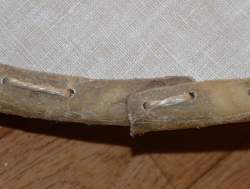
rawhide edge
Preparing the rawhide
First, the rawhide is soaked in water. To avoid the unpleasant smell and to clean the rawhide a little more, it helps to add some dishwashing liquid or all-purpose cleaner to the water. In the soaked state, the strip can then be cut to size, if necessary.
The problem with trimming is that the rawhide becomes longer and wider when soaking and contracts again when drying. In addition, the rawhide becomes wavy during drying. This equalises tensions in the material. So when the rawhide is dry and smooth, it is not tension-free and when it is tension-free, it is not smooth.
Since I get my rawhide from dog kaunoches that I can buy in the shop, it is necessary to soak it beforehand anyway. A good width for the strips is 4-5 cm.
Preparing the edge of the shield
 With a rawhide rim, it is good to round off the edges of the shield so that the rawhide does not rest on a corner later, as this will damage the rawhide more quickly. If fabric is glued onto the shield, it can also be glued around the edge before the rawhide is attached, so that the shield edge becomes slightly thicker and softer. This additionally cushions the blows on the rawhide.
With a rawhide rim, it is good to round off the edges of the shield so that the rawhide does not rest on a corner later, as this will damage the rawhide more quickly. If fabric is glued onto the shield, it can also be glued around the edge before the rawhide is attached, so that the shield edge becomes slightly thicker and softer. This additionally cushions the blows on the rawhide.
Attach wet or dry
 Many attach the rawhide when wet. I prefer to do this in the dry state. Which is preferred is basically a matter of taste. When attached wet, the rawhide creates additional tension on the shield. With a plank joined shield this is advantageous as the tension adds to the shield holding it together. With a plywood shield it is more of a disadvantage, as the tension on the rawhide leads to faster wear of the rawhide.
That's why I sew in a dry state.
Many attach the rawhide when wet. I prefer to do this in the dry state. Which is preferred is basically a matter of taste. When attached wet, the rawhide creates additional tension on the shield. With a plank joined shield this is advantageous as the tension adds to the shield holding it together. With a plywood shield it is more of a disadvantage, as the tension on the rawhide leads to faster wear of the rawhide.
That's why I sew in a dry state.
Shaping the strips
 The strips are placed on the shield edge and fixed with glue clamps, clothes pegs or similar to dry. Care should be taken to ensure that the rawhide strips overlap sufficiently, as they will shrink as they dry.
Depending on the length of the strips, the need varies. Usually 5 cm overlap is good.
The strips are placed on the shield edge and fixed with glue clamps, clothes pegs or similar to dry. Care should be taken to ensure that the rawhide strips overlap sufficiently, as they will shrink as they dry.
Depending on the length of the strips, the need varies. Usually 5 cm overlap is good.
During drying, the clamps should be moved once or twice, as the rawhide dries worse underneath. I also put a piece of cloth under the clamps so that they do not leave a pattern of marks. This also helps them to dry. Once they are dry, check the fit on the edge of the shield and move them a bit if necessary so that the overlaps are even.
Sewing
 Then pre-drill the holes with a drill and sew the rawhide with parcel string, saddler's thread taken several times or similar. It is best to sew a saddler's seam. This means that two needles are used in parallel with a single pre-stitch. Fastening by means of a seam has the advantage over nailing that nothing sharp sticks out if the edge is damaged in battle and the shield is actively used.
Then pre-drill the holes with a drill and sew the rawhide with parcel string, saddler's thread taken several times or similar. It is best to sew a saddler's seam. This means that two needles are used in parallel with a single pre-stitch. Fastening by means of a seam has the advantage over nailing that nothing sharp sticks out if the edge is damaged in battle and the shield is actively used.
